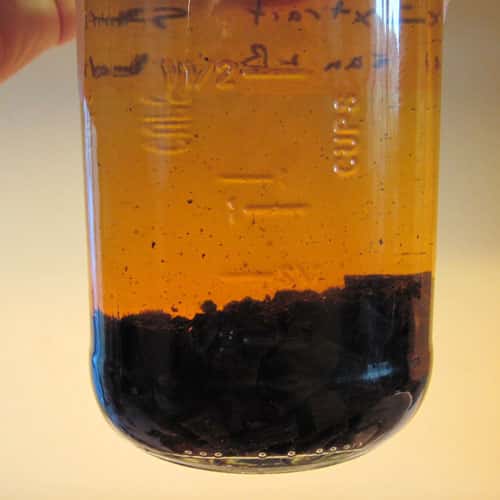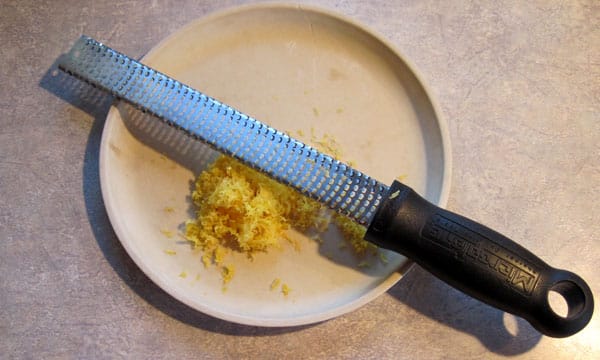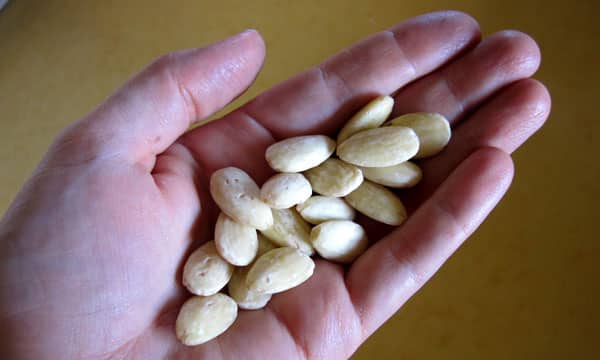I do a fair amount of baking, especially once the weather gets cooler, so I figured I could save quite a bit of money if I learned how to make homemade extracts. It turns out it couldn’t be much simpler – the biggest skill required is patience – and I can have plenty of extract for pennies on the dollar compared to buying high quality extract.
This post covers how to make the three homemade extracts I use the most – vanilla, almond and lemon.
Always make sure all your containers and kitchenware are well cleaned. If you want, you can sterilize by boiling for ten minutes, plus one minute per every 1000 feet above sea level. I haven’t boiled, I’ve just used well-washed everything, and I haven’t had any problems.
How to Make Homemade Vanilla Extract
1. Use 2 ounces of vanilla beans and one pint vodka for every pint of extract that you want to make. (For one cup of extract, use one ounce, and so on.)
2. Chop the beans into 1/4 to 1/2 inch long pieces. Many recipes call for slicing and scraping, but if you simply cut the beans into small pieces, you can get the same results with much less mess and effort.
3. Place the cut vanilla beans in a lidded, glass jar with 80 proof (40% alcohol by weight) vodka. I prefer to use vodka bottled in glass rather than plastic, and watch for whatever’s on sale. Lately I’ve been using Svedka. You can see the bean pieces at the bottom of the jar and the floating vanilla flecks.

4. Shake the bottle once a day for at least a month, and you have homemade vanilla extract. I usually aim for two to three months. The color and flavor will deepen with age.
5. Strain the finished extract through cheesecloth or a coffee filter and place in a dark bottle. You can order bottles online or find them in some specialty stores, or reuse empty extract bottles that you already have on hand. Alternatively, you can measure right out of your brewing bottle and continue to let the rest steep, or pour off some and let the rest steep. I like to bottle what I’m using separately to reduce any risk of contamination from dipping into an open jar (even if it is filled with alcohol). You really don’t need to strain if you’re just pouring off the top, and you can add more alcohol a few times (depending on how much you draw off and how strong your beans are).
6. Store in a cool, dark location.
If you buy the vanilla beans in bulk you can save even more (I have split orders with friends). You can also buy assortments of beans and mix and match types for subtle flavor differences. I think my homemade extract with a mix a beans tastes and smells as good or better than any commercial extract I’ve tried.
How to Make Homemade Lemon Extract
1. Combine the zest from 1 lemon, 1 teaspoon sugar and ½ cup 80 proof (40% alcohol by weight) vodka. Don’t use the pith (white part) of the lemon- just stick to the yellow – as the pitch is bitter. I like to use my Microplane zester to get a beautiful, fine lemon zest.

2. Place zest, sugar and vodka in a lidded, glass jar.
3. Shake the bottle once a day for at least a month, and you have homemade lemon extract. I usually aim for two to three months. The flavor will improve with age.
4. Strain the finished extract through cheesecloth or a coffee filter and place in a dark bottle. Alternatively, just pour off a small portion for use and allow the rest to continue steeping.
5. Store in a cool, dark location.
How to Make Homemade Almond Extract
Commercial almond extract is made with bitter almonds, which contain a cyanide precursor, which I don’t suggest brewing at home.; In fact, some folks argue that you should not use natural almond extract at all, only the synthetic. For my part, I’m more likely to trust nature than chemists. I’ve read that the same pits and seeds that contain the cyanide precursors also contain anti-cancer compounds. I don’t go out of my way to consume extra seeds and pits, but I don’t worry if they occasionally get eaten.
These instructions are based on the E-how post “How to Make Your Own Almond Extract“. By now, you know the drill, but we’ll go through the steps and proportions.

1. Use 12 whole, raw skinless almonds and one pint 80 proof (40% alcohol by weight) vodka for every pint of extract that you want to make.(For one cup of extract, use 6 almonds, and so on.) My almonds had been in the freezer for while, so I used more. The skins will make the extract more bitter, so it’s best to opt for skinless. Better tasting almonds make better tasting extract.
2. Chop almonds and place almonds and vodka in a lidded, glass jar. More surface area means more flavor transfer from almonds to alcohol.
3. Shake the bottle once a day for at least a month, and you have homemade almond extract. I usually aim for two to three months. The flavor will improve with age.
4. Strain the finished extract through cheesecloth or coffee filter and place in a dark bottle. Alternatively, just pour off a small portion for use and allow the rest to continue steeping.
5. Store in a cool, dark location. This extract will not taste as strong as commercial almond extracts, so you may want to make a small batch and see if you like it before making it in quantity.